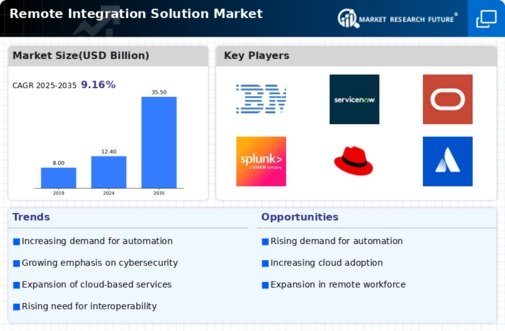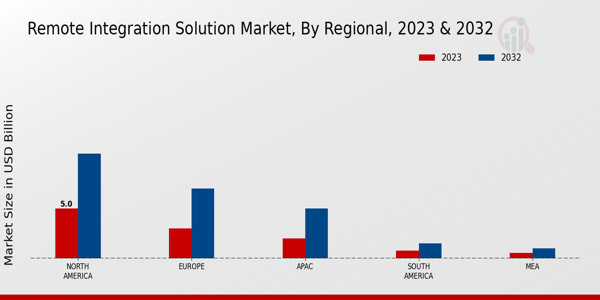Market Growth Projections
The Global Remote Integration Solution Market Industry is poised for substantial growth, with projections indicating a market size of 12.4 USD Billion in 2024 and an anticipated increase to 35.5 USD Billion by 2035. This growth trajectory reflects a compound annual growth rate (CAGR) of 10.05% from 2025 to 2035. The increasing adoption of remote integration solutions across various sectors is driving this expansion, as organizations seek to enhance operational efficiency and streamline processes. The market's growth is indicative of a broader trend towards digital transformation, where businesses are increasingly relying on integrated solutions to navigate the complexities of modern operations.
Technological Advancements
Technological advancements play a crucial role in shaping the Global Remote Integration Solution Market Industry. Innovations in cloud computing, artificial intelligence, and machine learning are driving the development of more sophisticated integration solutions. These technologies enable organizations to connect disparate systems, automate workflows, and gain valuable insights from data. As businesses increasingly rely on data-driven decision-making, the demand for advanced remote integration solutions is expected to grow. This trend suggests a robust growth potential for the market, with a projected CAGR of 10.05% from 2025 to 2035, as organizations seek to leverage technology for enhanced operational efficiency.
Growing Demand for Automation
The Global Remote Integration Solution Market Industry is experiencing a surge in demand for automation across various sectors. Organizations are increasingly adopting remote integration solutions to streamline operations, enhance productivity, and reduce operational costs. For instance, industries such as manufacturing and logistics are leveraging these solutions to automate processes, which leads to improved efficiency. As a result, the market is projected to reach 12.4 USD Billion in 2024, reflecting a growing recognition of the benefits of automation in driving business success. This trend indicates a shift towards more integrated and automated systems, which is likely to continue shaping the industry.
Rising Cybersecurity Concerns
The Global Remote Integration Solution Market Industry is also shaped by rising cybersecurity concerns. As organizations adopt remote integration solutions, they become more vulnerable to cyber threats. Consequently, there is a growing emphasis on integrating robust security measures within these solutions. Companies are increasingly prioritizing cybersecurity to protect sensitive data and maintain operational integrity. This heightened focus on security is likely to drive demand for remote integration solutions that incorporate advanced security features. As a result, the market is expected to witness significant growth, reflecting the need for secure and reliable integration solutions in an increasingly digital landscape.
Increased Focus on Remote Work
The Global Remote Integration Solution Market Industry is significantly influenced by the ongoing emphasis on remote work. Companies are increasingly investing in remote integration solutions to facilitate seamless collaboration among distributed teams. This shift is not merely a response to changing work environments but also a strategic move to enhance operational flexibility. As organizations recognize the importance of maintaining productivity in a remote setting, the demand for robust integration solutions is expected to rise. This trend is likely to contribute to the market's growth trajectory, potentially reaching 35.5 USD Billion by 2035, as businesses seek to optimize their remote work capabilities.
Regulatory Compliance Requirements
Regulatory compliance requirements are a significant driver in the Global Remote Integration Solution Market Industry. Organizations across various sectors must adhere to stringent regulations regarding data privacy and security. As compliance becomes more complex, companies are turning to remote integration solutions to ensure they meet these requirements effectively. These solutions facilitate the secure exchange of information while maintaining compliance with industry standards. The increasing complexity of regulatory frameworks is likely to propel the demand for remote integration solutions, as organizations seek to mitigate risks associated with non-compliance. This trend underscores the importance of integrating compliance considerations into remote integration strategies.























